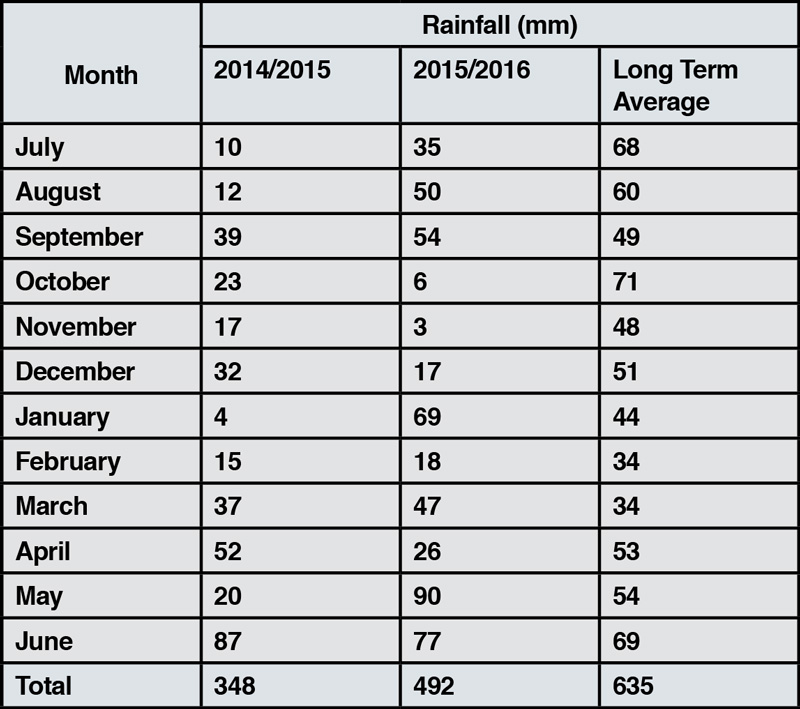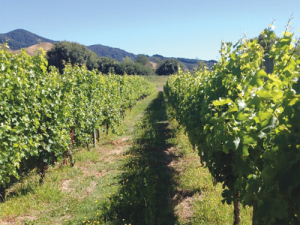With climate change will come more extremes of weather. That could well mean more sustained periods of drought in some of our major grape growing regions, especially Marlborough.
In Marlborough for the past two growing seasons wine grape growers have had to contend with two very dry years.
The 2014/15 season was the driest in 85 years of records leading to restrictions to a number of water schemes with several growers reduced to tanking in water supplies with all the associated costs and limited volume.
There were reports of water stress negatively affecting both yield and quality.
Through the following winter into early summer the dry trend continued with the driest areas (Blenheim locality, Dashwood and Blind River) only receiving between 20 and 26 mm rain between mid October and the 31st December 2015.
Fortunately for the industry two timely and substantial rain events in January followed by another in February averted the need for sequential seasons of substantial water supply restrictions. (See figure 1. for rainfall records).
However the issues in recent years has focused grower’s minds on water security. With climate change a reality, droughts are likely to become more frequent. So what can be done in practical terms to prepare for those tough summers?
Store water or invest in an alternative source
The best way to ensure water security if your source is restricted in dry years is to store water on site e.g. in a dam or invest in an alternative such as a backup bore hole or join a local irrigation scheme (if not likely to be subjected to similar restrictions).
Variety and clone selection
Crop water requirements are directly related to canopy size and crop loading and at the development stage variety or clone selection can help mitigate limited water availability. Varieties and clones such as Pinot Noir and the Chardonnay Mendoza clone where the natural or planned production is low (five – nine tonnes per hectare) will have a significantly lower water requirement than higher yielding varieties like Sauvignon Blanc and Pinot Gris (10 to 18 tonnes per hectare).
On a mixed variety vineyard if water is limited then irrigation allocation preferential to the higher demand varieties will help reduce demand overall with less production risk.
Soil type and ‘pre-loading’ with water prior to restrictions
Before deciding on any drought mitigation actions consider your soil. In general, free draining stony soils will have a low water holding capacity and therefore watering as much as possible before restrictions can have a negative effect further down the line as you will be giving a temporary luxury amount that can cause more of a shock to the vines when the readily available water (RAW) runs out. E.g. some stony riverbed soils may only have 50 to 60 mm RAW which in mid summer with high ET levels would only provide two to three weeks crop use. Pre-loading medium to heavy soils is a possible option but one needs to be sure that restrictions are not going to last so long that the switch off shock does not still occur. In addition if the pre loading is likely to produce a too vigorous canopy that not only uses more water but could well cause issues with disease and increase the costs of trimming. Silt loams in Marlborough tend to produce large canopies in particular. Our advice is to give adequate irrigation up to cut off but not try to refill the whole profile on the majority of soils.
The exceptions are clay based soils on hills and slopes which once dried out are very difficult to re-wet. There is a stronger case to pre-load those soils which tend not to produce such vigorous canopies and can suffer water stress quite frequently.
 Practical on site drought mitigation solutions
Practical on site drought mitigation solutions
Assuming water storage or alternative sources are not readily available or affordable options there are ways to reduce the impact of dry seasons and these are most effective if planned ahead.
Crop water use is directly related to canopy volume and yield, reduce canopy and/or fruit volume and you will reduce water use. If canopy growth is too large and luxurious then there will be more of a shock to the vines if water is suddenly switched off. If restrictions are expected then better to reduce irrigation ahead so the shock is less. Likewise thin crops to a level that is likely to be able to be supported and ripened during a dry season.
Keep on top of vine maintenance
Regular and timely trimming will also help reduce water stress, it is clear from our soil moisture monitoring that there is an immediate and significant drop in crop water use after trimming and plucking.
Under vine management
If your water source is likely to be shut off, under vine weeds and in particular grasses should not be allowed to establish. Well watered grass can easily be using five mm plus per day in January and means much of your irrigation water will be used by the grass before it reaches the vine roots. If organic weed control is used, then under vine cultivation is preferable to mowing.
However ideally under vine cultivate well in advance of restrictions as soil moisture lost by evaporation increases after cultivation. A substantial mulch applied in the spring to retain moisture and suppress weeds is ideal. Mulches applied to dry soil should be avoided as they reduce irrigation infiltration. Herbicide strips are good at retaining moisture as a consolidated crust builds up although that is not ideal from a soil structure or irrigation infiltration point of view.
Encourage deeper rooting
In newly developed vineyards excessive irrigation will limit rooting depth and mass. If water issues are likely, moderating irrigation in young vines so that they are actively looking for water is important. The deeper and bigger the root system becomes, the better they are able to tolerate dry periods. Growers looking to ‘dry farm’ vineyards slowly reduce irrigation inputs over as much as 10 years to gradually adapt vines to periods of significantly limited soil moisture. A moderate use of this approach with regulated deficit irrigation can help build up better dry period tolerance without sacrificing yield.
Cultivating alleyways
To reduce competition further some grower’s herbicide off grass alleys or cultivate them. After cultivating immediately roll to retain soil moisture and reduce evaporation.
Irrigation management
When irrigation is available maximise its effectiveness. If possible irrigate at night to reduce losses from evaporation. If a consolidated surface has been produced, typically when using herbicide strips, then pooling, evaporation loss and poor infiltration can occur. Breaking up the crust or mulch will alleviate this issue. If only very limited irrigation is available e.g. from tanked in water it is better to irrigate for a longer period more intermittently for that water to be as effective as possible, e.g. better to water 1.5 hours every third day than half an hour per day.
Marlborough has had significantly more rainfall so far this winter with Blenheim receiving 167 mm of rain in May/June 2016 compared with 107 mm for the same period in 2015. Hopefully this will continue so that soils and aquifers are better recharged by budburst compared with the past two seasons meaning less pressure on water supply in November and December.
However with increasing demand for water in the region and proposed changes to future water allocation currently at the submission stage within the Marlborough Environment Plan, security of water supply will be an increasing focus for growers in the future.
Nothing beats having a back up supply so that there is minimal risk to production. But for those growers without that luxury there are still a range of options to help mitigate the effects of water restrictions.






 Practical on site drought mitigation solutions
Practical on site drought mitigation solutions





